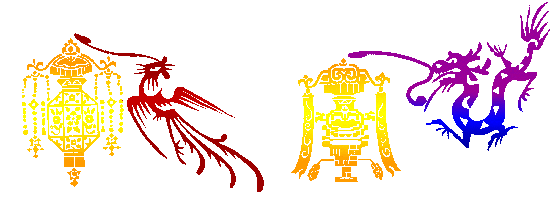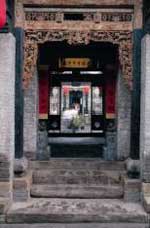
China - June 2002
Shanxi Provence - Taiyuan
|
Pingyao Ancient City is one of China's most well-preserved ancient towns. It was a military and commercial canter for 2,000 years. The city wall was first built during the Zhou Dynasty (11th century - 256 B.C.) and was expanded in 1370, the third year of the reign of Ming Emperor Hongwu. Now Pingyao city is the only one in China completely reserved as it was hundreds of years ago, no modern buildings, only narrow stone-plate street with many Chinese-style shops on the two sides. The perimeter of this square city is 6.4km long and the city wall is the earliest and largest intact city wall in China. It is 12m high with an average width of 5m. The wall is rammed earth strengthened with a covering of bricks. Outside the city wall there is a moat, 4m wide and 4m deep. The city has six gates, two each on the east and west and one each in the south and north side. All the gates project outwards and have two doors each. This has given the city the name "Turtle City" with the two gates on the south and north representing the head and tail of the turtle and four gates on the east and west as the four legs. Located on the trade route between Beijing and Xi'an, Pingyao developed into a merchant center where enterprising locals set up the nation's earliest banks. These institutions were the first in China to use checks, and business peaked in the 19th Century, when the city was the undisputed financial center of the Qing government. |
Morgan liked the defensive weapon guarding the entrance |
|
The "Ri Sheng Chang Money Exchange Shop" is the first Remittance Bank of China. RI Sheng Chang was established in the early Qing Dynasty. It was China's forerunner for organizing Chinese early finance system, handling remittance, money exchange, deposit, loan and other financial business. There were 35 branches in China's big and medium-sized cities. Its business covered Europe, America and Southeast Asia. |
Doing calligraphy |
|
Pingyao City gave me the feeling of a reconstructed
tourist place, where the locals do things the way it was done eons ago.
But I don't think that they were doing things to amuse the tourists. I
think they really still did things the old way.
|
Making Shoes by hand |
|
Knife sharpening |
Selling meat on the street. Its 90 degrees and the meat is not refrigerated, but it seems to work form them. |
|
Street market |
Spikey with her Chinese friend outside of the city walls |
 |
|
 |
Our last stop on the awesome tour was to the residence of the famous Shanxi Merchant, Qiao Zhiyong. It gained its fame because the movie "the Red Lanterns" by director Zhang Yimu was filmed there.. The mansion occupies an area of 8,000 square meters and has six major courtyards and 19 minor ones, with 313 rooms. The mansion is laid out in the shape of the Chinese character Xi(happiness). |
|
Our fantastic trip was finally over. We had an awesome time. |
|
 Back
to Home page Back
to Home page |
|
|
|
|